Romspectraimpex.ro

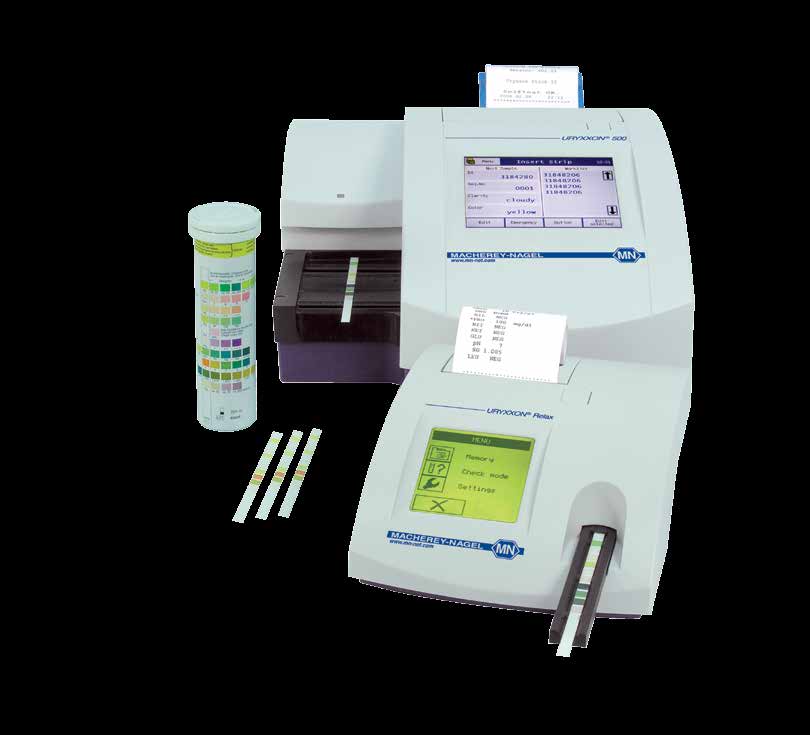
with Test Strips
URYXXON® Relax –
automated urine analysis at the point of care
URYXXON® 500 –
high performance urine analysis
MACHEREY-NAGEL GmbH & Co. KG · Neumann-Neander-Str. 6-8 · 52355 Düren · Germany
EN ISO 9001: 2008
Tel.: +49 (0) 24 21 96 90
Tel.: +41 (0) 62 388 55 00
Tel.: +33 (0) 3 88 68 22 68
Tel.: +1 484 821 0984
Fax: +49 (0) 24 21 96 91 99
Fax: +41 (0) 62 388 55 05
Fax: +33 (0) 3 88 51 76 88
Fax: +1 484 821 1272
E-mail: [email protected]
E-mail: [email protected] E-mail: [email protected]

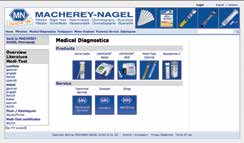
MACHEREY-NAGEL - The Company
Welcome to MACHEREY-NAGEL
We are pleased that you are interested in our high-quality medical test strips. This bro-
chure gives you an overview over our different products and applications in the fields
of urine and blood analysis.
Filtration · Rapid Tests · Water Analysis · Chromatography · Bioanalysis
Filtration · Schnellteste · Wasseranalytik · Chromatographie · Bioanalytik
MACHEREY-NAGEL – The Company
Since its foundation in 1911, the roots of MACHEREY-NAGEL are the production of high-
- Quality made in Germany
quality filter papers. Since the fifties, we have developed filter papers into top quality test
papers for laboratory use. Today, we offer the world's largest selection of different test pa-
pers. Additionally, we offer a versatile programme of special products for analytical chemis-
try including chromatography, water analysis and bioanalysis.
The production facilities of our test strips, as well as our company headquarter, are located
in Düren (Germany). Local sales offices for test strips are found in Switzerland, France and
the US.
MACHEREY-NAGEL – Medical test strips
- Urine analysis for more
In the late seventies, MACHEREY-NAGEL started producing high-quality test strips for
than 30 years
urine analysis. At that time, we were the fourth manufacturer of such test strips world-wide.
Since then we have continuously developed the chemistry of our test strips. We are proud
that today customers in more than 70 countries trust the outstanding quality of our medical
test strips.
In addition, many pharmaceutical companies rely on MACHEREY-NAGEL. pH test
- Special pH papers for the
strips manufactured by MN are used to monitor the dosing of different medications.
pharmaceutical industry
They are CE-marked according to the IVD Directive 98/79/EC.
MACHEREY-NAGEL – Certified quality
- EN ISO 13485 and
Already since 1996, MACHEREY-NAGEL is certified according to EN ISO 9001. Obviously,
EN ISO 9001 certified
we are also certified according to the Medical Devices Directive EN ISO 13485. Today we
are among the few manufacturers who can offer urine test strips with CE certification not
only for professionals, but also for patient self-testing.
MACHEREY-NAGEL meets your needs
- We are pleased to advise
If you have any questions concerning the Medi-Test products in this catalogue please feel
free to contact us:
Technical support and customer service:
+49 24 21 969-138
+49 24 21 969-161
+49 24 21 969-174
+49 24 21 969-190
Product Management Medi-Test:
+49 24 21 969-166
Please visit our Medi-Test Pages:
Tel. +49 24 21 969-0
Toll-free 0800 / 2616 000
Fax +49 24 21 969-199 or -198
E-mail [email protected]
Tel. +33 388-68 22 68
Fax +33 388-51 76 88
Tel. +41 62 388 55 00
Fax +41 62 388 55 05
Tel. +1-484-821-0984
Toll-free 888-321-6224 (MACH)
Fax +1-484-821-1272
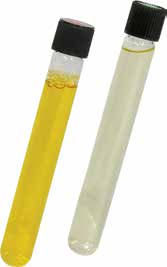
Urine Analysis with Test Strips
Urine Analysis with Test Strips
The use of urine test strips is acknow- This saves considerable costs for the - Urine test strips offer
ledged as a modern screening method healthcare system and avoids unnecessary a rapid survey of a patient's
in medical practice. With these non-invasive examinations for the patient.
health status
tests important information on the health Urine test strips from MACHEREY-NAGEL
status of patients is rapidly obtained. The are especially user-friendly. Due to the high
urine sample is easily drawn and can be resistance towards ascorbic acid interfer- - Urine chemistry – rapid and
investigated immediately with a test strip. ences a second testing for sensitive pa- reliable
Thus one obtains results within minutes, rameters such as blood or glucose is un-
which facilitates the decision on further di-
necessary in most cases. The optimized,
agnostic and therapeutic action.
flexible shape of the test strips also allows - Flexible strip design for
Only on pathological results for certain pa-
the examination of very small amounts of small volume urine
rameters, a subsequent, e.g. microscopic, urine. This makes urine analysis reliable samples
examination of the urine is necessary. If and easy.
the test strip result is without pathologi-
cal findings and the patient is not clinically
conspicuous, further time- and cost-inten-
sive investigations can often be avoided.
Best available vitamin C protection1)
he test pads for glucose and blood have
(10 mg/dL)
The Medi-Test technology overcomes the
the best available protection against
influence of vitamin C. This ensures optimal
interferences caused by vitamin C (ascor-
and safe results for all important urine pa-
bic acid). This ensures correct results even
when fruit juice or vitamin tablets are con-
sumed. Eating restrictions do not apply.
To ensure downward compatibility Medi-Test Combi 11
does not feature the optimal vitamin C protection.
(100 mg/dL)
The excretion of vitamin C is harmless in
itself. However, vitamin C interferes with im-
portant oxidation reactions. With many test
strips this leads to false negative readings
for blood and glucose.
Concentration of vitamin C in
the sample, with no effect on
the results for blood and glu-
cose in urine (mg/dL)
Safe and easy quality control – Medi-Test Control
Medi-Test Control are specially formulat- The reagents can be used immediately with-
ed control reagents to ensure optimal out any further preparation and the large re-
and convenient quality control for Medi-Test agent tubes make working with Medi-Test
urine test strips and URYXXON® strip read-
Control particularly easy.
ers. It is free of biological urine or any other
biologically hazardous material and there-
fore does not need hazardous labelling.
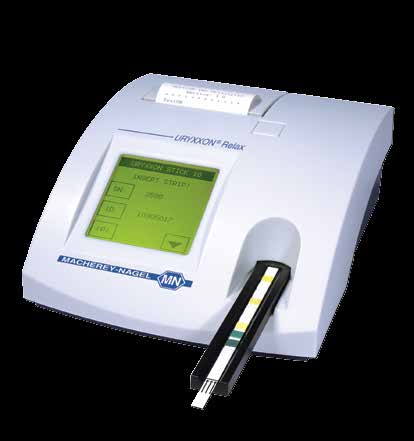
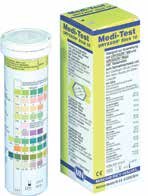
URYXXON ® Relax
URYXXON® Relax – automated urine analysis at the point of care
- 50 measurements/h
- Autostart
The URYXXON® Relax provides depend- Technical specifications
able urine status results to detect early Capacity
stages of many diseases such as diabetes, ·
- High precision optics
kidney disease and urinary tract infections.
Instrument-read results have long proven to Instrument memory
be advantageous for both busy health care
200 patient test results including name
professionals and patients. URYXXON® Interface
Relax readings eliminate the subjectiv-
· User: Touch-screen display, alphanu-
ity of visual color interpretation. The com-
meric input, password protection
prehensive interface options and the opti-
· Computer: USB interface for connection
mized printouts minimize risks associated to PC alternatively RS 232 interface for
with manual transcriptions. Reliable results connection to PC and PS/2 interface for
can be obtained immediately at the point of connection of keyboard and/or barcode
The URYXXON® Relax makes urine analy-
· 110-240 V AC, automatic
sis easier and more reliable.
· Battery powered operation (optional)
with 6 AA batteries
Dimensions / Weight
· Depth: 20 cm (8 inches)
· Width: 16 cm (6 inches)
· Height: 7.5 cm (3 inches)
· Weight: 710 g (1.90 lb)
(without batteries and power supply)
· Temperature range: 5-40 °C
· Humidity range: 20-80% relative humi-
dity, non condensing
- Medi-Test
URYXXON® Stick 10
· Calibration: automatic, self-calibrating
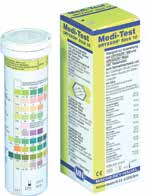
URYXXON ® 500
URYXXON® 500 – high performance urine analysis
The URYXXON® 500 is an automatic Technical specifications
- 400 measurements/h
reader for URYXXON® Stick 10 urine Capacity
test strips. With a capacity of 400 strips per ·
- Easy to use
hour, it is ideal for use in hospitals and prac-
- Compact design
tices. The "easy-to-use-features" allow hy-
gienic operation with hardly any training.
· 500 patient test results including
name or patient ID
® 500 provides dependable ·
urine status results to detect early stages of
User: Touch-screen display, alphanu-
many diseases such as urinary tract infec-
meric input, password protection
tion, kidney diseases or diabetes. The de-
· Computer: 1 x USB and 2 x RS232 inter-
vice eliminates the subjectivity of visual strip faces for connection to PC, PS/2 inter-
face for connection of keyboard and/or
evaluation and minimizes risks associated barcode reader
with manual result transcription.
· 110-240 V AC, automatic
The URYXXON® 500 makes urine analysis
quicker, easier and more reliable.
Dimensions / Weight
· Depth: 24 cm (9.5 inches)
· Width: 28 cm (11 inches)
· Height: 15 cm (5.9 inches)
· Weight: 3.9 kg (10.5 lb)
(without power supply)
· Temperature range 5-40 °C (41-104 °F)
· Humidity range: 20-80% relative humid-
ity non-condensing
· Calibration: automatic, self calibrating - Medi-Test
URYXXON® Stick 10
Significance of the parameters
The medical context of urine parameters
Urine test strips are indispensable tools in medical diagnostics to gain a rapid survey of the state of health of a patient.
Parameters of the Combi 10® SGL
Blood: Serious infections of the kidneys and urinary tract, urolithiasis,
suspected renal or bladder neoplasms
Urobilinogen: Acute and chronic liver parenchyma damage, hemolytic
jaundice, pathological state of the intestinal tract
with test fields for Glucose,
Bilirubin: Liver parenchyma damage, obstructive jaundice
(also for indicating biliary obstructions)
Protein: Symptomatic of renal and urinary tract diseases
Liver and bile
Nitrite: Bacterial infection of kidneys or urinary tract
with test fields for Bilirubin,
Ketones: Metabolic abnormalities,
indication of ketoacidosis
Glucose: Early detection and supervision
Kidneys and
of diabetes mellitus
urinary tract diseases
pH: Useful in relation to other parameters
with test fields for Protein, Blood, Leukocytes
Nitrite, Density, pH value
Density: Concentration ability of kidneys,
supplement for other parameters
Leukocytes: Symptomatic of inflammatory
renal and urinary tract diseases
Easy detection of urine adulteration – Medi-Test Adulteration Stick
recently, commercial adulterants became - Improves integrity of
urine testing
Adulteration is the intentional tamper-
ing with a urine sample by the donor to available with names like Urine Luck, Klear
avoid detection of illicit drug use. Success-
ful adulteration produces a false-negative Medi-Test Adulteration sticks reliably de-
drug test result.
tect unusual levels of Creatinine, Nitrite,
An estimated 4% of all urine samples sub-
Glutaraldehyde, pH, Density and Oxidants
mitted for drugs-of-abuse testing in the USA generally connected with classic or com-
is adulterated. With the easy access to in-
mercial adulterants. Removing adulterated
formation from the internet, the number of samples for drugs-of-abuse testing saves
adulterated specimens is increasing. Re-
money and increases the integrity of the
cently, urine adulteration has also become testing program.
a problem in Europe.
Classic adulterants include many com-
monly available household substances like
water, bleach, baking soda or vinegar. More
Urine test strips for animals – Combi 10® VET
dividual tests for the different species. - Urine test for animals:
rapid and easy
The examination of the urine of small ani-
mals (dogs, cats, rabbits, guinea pigs This makes urine analysis of small ani-
etc.) provides valuable information for the mals safe and easy.
diagnosis of urinary tract disorders and
diseases. Ideally, a urine sample should
be obtained through cystocentesis. How-
ever, the examination of spontaneous urine
is often adequate for an initial diagnosis.
First, all urine samples undergo a macro-
scopic examination. The urine volume,
colour, transparency and smell are evalu-
ated.
Using Medi-Test Combi 10® VET the urine
status can easily be evaluated. The leaf-
let describes characteristics of the in-
Principle, Evaluation, Sources of error, Diagnosis of
test field parameters
An inhibitory effect is produced by gentisic
Principle: The detection is based on the glu-
acid. Falsely posi-
cose oxidase-peroxidase-chromogen reac-
tive reactions can
tion. The oxidation of glucose by atmospheric also be produced
oxygen is catalyzed by glucose oxidase to by a residue of per-
form gluconic acid lactone and hydrogen oxide-containing
peroxide. Peroxidase catalyzes the reaction cleansing agents.
of hydrogen peroxide with the chromogen. The test is not in-
Apart from glucose, no other compound in fluenced by vitamin C (for Combi 11 please
urine is known to give a positive reaction.
read the foot note on page 3).
- Early detection of
diabetes mellitus
Evaluation: Pathological glucose concen-
Diagnosis: Because of the clear distinction
trations are indicated by a color change between physiological and pathological gluco- - Supervision of
from green to bluish green. Yellow or green-
suria, the test is especially suitable for the de- type-II-diabetics
ish test fields should be considered nega-
tection of diabetes mellitus and for supervis-
tive or normal. All test fields which have an ing (and self-supervising) of diabetes. Apart
intensity greater than the greenish nega-
from diabetes mellitus, renal glucosuria with
tive color field must be considered posi-
increased glucose concentrations may be
tive. The color fields correspond to the fol-
noted during pregnancy, and after a meal with
lowing ranges of glucose concentrations: excessive carbohydrates. Every positive test
neg. (yellow), neg. or normal (greenish),
reaction requires further diagnosis.
50, 150, 500 and ≥1000 mg/dL or
neg. (yellow), neg. or normal (greenish),
2.8, 8.3, 27.8 and ≥55.5 mmol/L.
Diagnosis: The pH value is only of signifi-
Principle: The test paper contains indicators, cance in relation to
which clearly change color between pH 5 and other parameters.
pH 9 (from orange to green to turquoise).
Evaluation: The pH value of fresh urine from (lower pH values) is
healthy people varies between pH 5 and pH 6. found in case of an
The color scale gives a clear distinction of pH increased protein
value between pH 5 and pH 9. The pH should metabolism, high
always be measured in fresh urine, since bac-
fever, serious diar-
- Diseases of the
terial decomposition may increase the pH of rhoea and metabolic acidosis (serious form urogenital tract
the urine to values > 9.
of diabetes mellitus). Alkalinity (increased pH - Supplement for other
value) may be noted in urinary tract infec- parameters
tions, respiratory or metabolic alkalosis.
- Backup for
microscopic results
Diagnosis: Ketone bodies including acetoa-
Principle: The test is based on the principle cetic acid, acetone,
of Legal s test. Acetoacetic acid and acetone and ß-hydroxybu-
form a violet colored complex with sodium ni-
tyric acid are only
troprusside in alkaline medium.
Evaluation: Acetoacetic acid reacts more sen-
liver. Ketones in the
sitively than acetone. Values of 10 mg/dL of urine are caused
acetoacetic acid or 50 mg/dL acetone are in-
dicated. The color fields correspond to the fol-
- Early detection of
lowing acetoacetic acid values:
tabolism. Frequently, ketonuria is a sign of ketosis / acidosis
diabetic ketosis, which in connection with
other metabolic abnormalities may cause dia- - Control-parameter for
25 (+), 100 (++) and 300 (+++) mg/dL
betic coma. Ketonuria may also be noted in Diabetes mellitus
case of insulin overdoses, starvation (e.g.
slimming diet, calorie free diet), dangerous
2.5 (+), 10 (++) and 30 (+++) mmol/L.
metabolic abnormalities during pregnancy
Phenylketones in higher concentrations inter-
(Hyperemesis gravidarum), acetonemic
fere with the test, and will produce deviating vomiting of infants and fever caused espe-
colors. ß-hydroxybutyric acid (not a ketone) is cially by infections.
not detected. Phthalein compounds interfere
by producing a red coloration.
the urine sampling vessel. The protein col-
Principle: The test oration may be masked by the presence of
is based on the medical dyes (e. g. methylene blue) or beet-
„protein error" prin-
root pigments.
ciple of indicators. Diagnosis: The limit of a physiological protein-
The test zone is uria lies between 10 and 30 mg/dL. It differen-
buffered to a con-
stant pH value and 1) Benign proteinuria is observed after physi-
changes color from
- Symptomatic of renal and
cal strain, orthostatic proteinuria, with fever
urinary tract diseases
yellow to greenish blue in the presence of al-
and during pregnancy. In such cases the pro-
bumin. Other proteins are indicated with less tein excretion rate is usually normal in the first
morning urine, however in the course of the
Evaluation: The test strip detects values day values can vary greatly.
above 10 mg protein/dL urine. The color fields 2) Extrarenal proteinuria frequently appears
correspond to the following ranges of albumin with acute diseases like heart insufficiency,
colics, liver cirrhosis, plasmocytoma, and car-
negative, 30, 100 and 500 mg/dL
3) Renal proteinuria is caused by increased
negative, 0.3, 1.0 and 5.0 g/L.
permeability of the glomerular filter and may
Falsely positive results are possible in strong-
indicate pyelonephritis, glomerulonephritis,
ly alkaline urine samples (pH > 9), after infu-
tuberculosis of the kidneys, kidneys participa-
sions with polyvinylpyrrolidone (blood substi-
tion at infections and poisonings, cystic kid-
tute), after intake of medicaments containing neys, gouty kidney. Every positive test reac-
quinine, and also by disinfectant residues in tion requires further diagnostic examinations.
used as preservative decreases the sensitivity
Principle: The test of the reaction.
is based on the es-
Excretion of bilirubin, nitrofurantoin, or other
terase activity of strongly colored compounds can cover the re-
granulocytes. This action color.
enzyme splits a car-
For samples from female patients vaginal
boxylic acid ester. secretion can simulate a falsely positive re-
The alcohol compo-
action. In order to avoid falsely positive re-
- Symptomatic for renal and
nent formed during sults, the urine should only be sampled after
urinary tract infections
this step reacts with a diazonium salt to form thorough cleaning of the genitals.
a violet dye.
Diagnosis: An increased excretion of leuko-
Evaluation: The test detects values from cytes in urine (leukocyturia) is an important
about 10 to 25 leukocytes/μL urine. Discolor-
symptom for infectious diseases of the kid-
ations, which can no longer be correlated to neys and/or urinary tract (incl. the prostate).
the negative test field, and weakly violet dis-
Leukocyturia is especially important for diag-
colourations after 120 seconds are to be con-
nosis of chronic pyelonephritis. Often it is the
sidered positive. The color fields correspond only symptom between acute attacks.
to the following leukocyte concentrations:
Other causes for leukocyturia may be:
negative (normal), 25, 75, 500 leukocytes/μL
analgetic nephropathia, glomerulopathia and
A diminished reaction can result for protein ex-
intoxications, cystitis, urethritis, kidney or uro-
cretion above 500 mg/dL, and a glucose con-
genital tuberculosis, fungus and trichomonade
centration above 2 g/dL as well as during ther-
infections, gonorrhoea, urolithiasis, tumors
apy with preparations containing cephalexin with obstructions.
or gentamycin. Bacteria, trichomonades and
erythrocytes do not give a positive reaction
with this test. Formaldehyde (a preservative)
can cause falsely positive reactions. Boric acid
test strip is 5 to 10 erythrocytes/μL urine cor-
Principle: The detec-
responding to approx. 0.015 mg hemoglobin
tion is based on the or myoglobin/dL urine. Intact erythrocytes are
pseudoperoxidative indicated by flecked discolourations of the test
activity of hemoglo-
field. The color fields correspond to the follow-
bin and myoglobin, ing values:
which catalyze the 0 (negative), ca. 5-10, ca. 50, ca. 250 Ery/μL,
oxidation of an indi-
cator by an organic hydroperoxide, producing
a green color.
a hemoglobin concentration out of ca. 10, ca.
50, ca. 250 Ery/μL.
Evaluation: The minimum sensitivity of the
The blood test on Medi-Test urine test strips is Serious infections of the kidneys and urinary tract, - Indicator for several seri-
ous diseases
optimally protected against interferences by as-
kidney and bladder calculi, serious poisonings
corbic acid. Normal concentrations of vitamin C (e. g. benzene and aniline derivatives, chlorate,
(< 40 mg/dL) do not influence the test result (for bacteria toxins, poisonous mushrooms and snake
Combi 11 please read the foot note on page 3). poison), heart attack, hemolysis after transfusion
However gentisic acid still shows an inhibitory ef-
incident, cold hemoglobinuria or march hemoglo-
fect. Falsely positive reactions can be produced binuria (after strong physical exertion), different
by a residue of peroxide-containing cleansing paroxysmal hemoglobinurias and serious hemo-
lytic anemias.
Diagnosis: Every positive reaction should be taken
as a pathological finding requiring further diagnos-
tic examinations. Hematuria (hemolysis of intact
erythrocytes occurs on the test field), hemoglobi-
nuria or myoglobinuria are frequently caused by:
py, and by very low nitrate concentrations in
Principle: Microorganisms, which are able to urine as the result
reduce nitrate to nitrite, are indicated indirectly of low nitrate diet
with this test, which is based on the principle or strong dilution
of Griess reagent. The test paper contains an (diuresis). Falsely
amine and a coupling component. Diazotiza-
positive results can
tion and subsequent coupling result in a red be caused by the
colored azo compound. Only nitrite can pro-
presence of diag-
duce a diazonium salt for coupling reaction, nostic or therapeutic dyes in the urine.
- Bacterial infection of the
therefore falsely positive results are virtually Diagnosis: Bacteria, which cause infections, kidneys or urinary tract
impossible in this case.
and can produce nitrite in the urine are e. g.
Evaluation: The test detects concentrations E. coli (bacteria which causes most frequently
from 0.05 to 0.1 mg nitrite/dL urine. Any pink infections), Aerobacteria, Citrobacteria, Kleb-
color indicates a bacterial infection of the uri-
siella, Proteus, Salmonellae and in part En-
nary tract. The color intensity only shows the terococci, Pseudomonas and Staphylococci. If
nitrite concentration, and does therefore not the test is positive a microscopic examination
provide information about the extent of the in-
and determination of susceptibility of patho-
fection. A negative result does not preclude an genic bacteria to chemotherapeutic agents
infection of the urinary tract, if bacteria, which should follow.
cannot produce nitrite are present. Falsely
negative results can be produced by high
doses of ascorbic acid, by antibiotics thera-
Ascorbic acid (Vitamin C)
acid (e.g. in vitamin C therapy, as a therapeu-
Modern Medi-Test urine test strips have the tical ingredient and
best available protection against influences of stabilizer of numer-
ascorbic acid (vitamin C) in the sample. For ous medicaments,
historic reasons, many test strips still feature a oxidation inhibitors
test pad for ascorbic acid (for Combi 11 please and preservatives
read the foot note on page 3).
in food industry)
Principle: The detection is based on the de-co-
causes a rapid sat-
louration of Tillman‘s reagent. The blue colored uration of the organism, and a renal excretion - High concentrations may
2,6-dichlorophenol indophenol sodium salt is of the excess. Interfering ascorbic acid con- disturb other test fields
reduced to the colorless leuco form by ascorbic centrations may be reached after the inges-
acid. In the presence of ascorbic acid a color tion of fruit juice or plenty of fruit. Therefore,
change takes place from blue to red.
the ascorbic acid test zone minimizes falsely
Evaluation: The color fields correspond to the negative results. As with glucose detection,
following values:
blood detection is also disturbed by low con-
centrations of ascorbic acid, whereas high
0 (negative), 10 (+) and 20 (++) mg/dL
ascorbic acid concentrations interfere with the
nitrite and bilirubin test zones.
0 (negative), 0.6 (+) and 1.1 (++) mmol/L.
Diagnosis: The wide spread intake of ascorbic
The test is inhibited by higher concentrations
Principle: The test of formaldehyde. Longer exposure of the urine
paper contains a to light leads to lowered or falsely negative re-
stable diazonium sults. Higher, or falsely positive results, can
salt producing a be caused by the presence of diagnostic or
therapeutic dyes in the urine. Larger amounts
of bilirubin produce a yellow coloration.
Diagnosis: An increased urobilinogen concen-
- Detection of liver diseases
Evaluation: Depending on the urine color 0.5 tration in urine is a sensitive index of liver dys-
to 1 mg urobilinogen/dL urine are indicated. function or hemolytic diseases. Urobilinogen-
- In combination with
1 mg/dL is considered to be the normal ex-
uria is caused by e. g. virus hepatitis, chronic
Bilirubin differentiation
cretion rate. Higher values are pathological. hepatitis, liver cirrhosis, infections, poison-
between different forms of
A complete absence of urobilinogen in the ings, congestion or carcinoma of liver, hemo-
jaundice
urine, which is likewise pathological, cannot lytic, and pernicious anemina, polycythemia
be detected with the strips. The color fields and pathological state of the intestinal tract
correspond to the following urobilinogen con-
with an increased resorbence.
normal (0 - 1), 2, 4, 8,12 mg/dL
normal (0 - 17), 34, 70,140, 200 μmol/L.
nitrite in higher concentrations inhibit the test.
Principle: A red Longer exposure of the urine to light leads to
azo compound is lowered, or falsely negative results. Higher, or
obtained in the falsely positive results can be caused by the
presence of acid presence of diagnostic or therapeutic dyes in
by the coupling of the urine.
bilirubin with a di-
Diagnosis Only conjugated (water soluble)
azonium salt.
bilirubin is excreted by the kidneys. Normally
- Detection of liver diseases
Evaluation: The minimum sensitivity of the bilirubin is undetectable in urine. Bilirubinuria
test strip is 0.5 to 1 mg bilirubin/dL urine. generally indicates liver parenchyma damage
- In combination with
The color fields correspond to the following (e. g. acute virus hepatitis and other forms of
Urobilinogen differentiation values:
hepatitis, liver cirrhosis, toxic liver cell dam-
between different forms of
age) or biliary obstructions (e. g. cholangitis,
jaundice
0 (negative), 1 (+), 2 (++), 4 (+++) mg/dL
Unconjugated bilirubin, which is detectable
0 (negative), 17 (+), 35 (++), 70 (+++) μmol/L.
in serum, indicating hemolytic jaundice is not
Some urine components can produce a yellow excreted by the kidneys and is absent from
coloration of the test strip. Ascorbic acid and urine.
Diagnosis: In kidney diagnostics determination
Principle: The test of the urine concentration is important
indicates the ion con-
for checking the function of the kidney
centration of urine parenchyma. If high liquid intake is excluded,
with good correlation a very dilute urine can indicate a substantial
to the refractometric insufficiency of the kidneys, and also a lowered
method. Increasing ability of the kidneys to concentrate the urine,
ion concentrations which may result from Diabetes mellitus,
cause a color change from blue-green via Diabetes insipidus, Hyperaldosteronism or
- Indication of the status of
green to yellow.
influence of diuretic drugs.
the kidney
Evaluation: The test allows determination of The density of the urine yields valuable
- Information about the state the urine density between 1.000 and 1.030.
supplementary information for the evaluation
of hydration
The normal value for adults with normal intake of other test strip parameters, and thus helps
of food and liquid is from about 1.015 to 1.025; to avoid misinterpretations, especially:
however, it can vary between 1.000 after � during lysis of leukocytes and erythrocytes
extreme liquid intake, and 1.040 after a longer for interpreting possible differences with
period of thirst. The density measured with test
the sedimentation results
strips can vary slightly from value determined � for evaluation of the test fields for nitrite,
with other methods, since density increases protein and glucose
due to glucose concentrations >1000 mg/dL Especially in the intermediate range, between
(>56 mmol/L) are not covered. Increased physiological and pathological results, the
protein excretion can result in density values, urine density can have a decisive role.
which are too high. Alkaline urines, with high
contents of buffer substances, often show
results, which are too low.
Blood test strips Glycaemie
Test strips Glycaemie
If the test results vary slightly from normal
Application: For initial orientation in monitor-
values, a quantitative (e.g.
ing diabetics or in suspected cases of diabe-
photometric) test should be
tes as well as for diabetes self-testing.
carried out. Within the area
Principle: Detection is based on the glucose-
of diabetes self-testing, the
oxidase-peroxidase reaction and reacts spe-
test does not and under no
cifically to glucose.
circumstances substitute
Evaluation: Visual evaluation by comparison regular controls from a phy-
with the color scale in the range of 20 – 800 sician. Self-monitoring of
mg/dL (1.1–44.4 mmol/L). Normal concentra-
glucose concentrations in
tions (fasting blood sugar) are between 70 capillary blood for diabetics
and 120 mg/dL (3.9–6.7 mmol/L).
resp. suspected diabetics.
Normal concentrations (fasting blood sug-
For monitoring of diabetics evaluation sys-
ar) are between 70 and 120 mg/dL (3.9–6.7 tems with higher accuracy should be applied.
Both hyperglycemia and hypoglycemia can be
determined with this test.
Instructions for use:
1. Open container. Remove one test strip. 2. Apply a good sized drop of blood to the
Do not touch the reaction zone!
test field.
>240 mg/dL: 180 s
3. After exactly 60 seconds wipe off the 4. After 120 s (if values are over 240 mg/dL
after 180 s) compare test fields with
the color scale.
Comparison of the results for Glycaemie C
with labor method
(photometric evaluation)
Medi-Test ordering information
Diagnostic test strips for urine analysis
with test fields for determination of
930 24 Glucose1)
930 20 Glucose/Keton1)
930 26 Glucose 31)
930 27 Protein 21)
930 28 Keton1)
930 29 Nitrit1)
930 37 Combi 21)
930 30 Combi 3 A®
930 32 Combi 5
930 36 Combi 5 N®
930 78 Combi 6
930 34 Combi 6 A
930 22 Combi 7
930 21 Combi 8 L
930 23 Combi 9®
930 56 Combi 10®
930 58 Combi 10® L
930 60 Combi 11
930 67 Combi 10® SGL
930 68 URYXXON® Stick 102)
Further Medi-Test urine test strips
Test strips for veterinary applications
930 870 Combi 10® VET3)
Test strips for detection of urine adulteration
Medi-Test Adulteration Stick3) for the detection of urine adulteration prior to drugs-of-abuse tests
with test fields for Creatinine, Glutaraldehyde, Nitrite, pH, Oxidants and Density
All products are CE-marked according to the directive 98/79/EC
1) suitable for patient self-testing 2) for evaluation with URYXXON® reflectometers 3) not an IVD product
Instruments for urine test strips
930 88 URYXXON® Relax, automated urine analysis at the point of care
930 080 URYXXON® 500, high performance automated urine analysis
Accessories and spare parts
930 38 Medi-Test Control, Solution to check Medi-Test urine test strips and URYXXON® instruments
930 65 Printer paper for URYXXON® Relax, Pack of 5 rolls
930 890 Strip adaptor for URYXXON® Relax
930 891 PC software for URYXXON® Relax
930 71 Printer paper for URYXXON® 300 and URYXXON® 500, Pack of 5 rolls
930 74 Barcode scanner for URYXXON® instruments
Test strips for semi-quantitative determination of glucose in blood (capillary blood)
Blood-glucose test strips
928 07 Test strips Glycaemie C (bicolored) for visual determination, Pack of 50 test strips1)
FlyUrine&Blood en12/1/0/1 KA Printed in Germany
MACHEREY-NAGEL GmbH & Co. KG · Neumann-Neander-Str. 6-8 · 52355 Düren · Germany
EN ISO 9001: 2008
Tel.: +49 (0) 24 21 96 90
Tel.: +41 (0) 62 388 55 00
Tel.: +33 (0) 3 88 68 22 68
Tel.: +1 484 821 0984
Fax: +49 (0) 24 21 96 91 99
Fax: +41 (0) 62 388 55 05
Fax: +33 (0) 3 88 51 76 88
Fax: +1 484 821 1272
E-mail: [email protected]
E-mail: [email protected] E-mail: [email protected]
Source: http://romspectraimpex.ro/downloads/medi-test-urina.pdf
TALN 2011, Montpellier, 27 juin – 1er juillet 2011 Accès au contenu sémantique en langue de spécialité : extraction des prescriptions et concepts médicaux Pierre Zweigenbaum1 (1) LIMSI-CNRS, BP133, 91403 Orsay Cedex, France (2) Département de Linguistique, Université de Genève, Suisse Résumé. Pourtant essentiel pour appréhender rapidement et globalement l'état de santé des patients, l'accèsaux informations médicales liées aux prescriptions médicamenteuses et aux concepts médicaux par les outilsinformatiques se révèle particulièrement difficile. Ces informations sont en effet généralement rédigées en textelibre dans les comptes rendus hospitaliers et nécessitent le développement de techniques dédiées. Cet articleprésente les stratégies mises en œuvre pour extraire les prescriptions médicales et les concepts médicaux dansdes comptes rendus hospitaliers rédigés en anglais. Nos systèmes, fondés sur des approches à base de règleset d'apprentissage automatique, obtiennent une F1-mesure globale de 0,773 dans l'extraction des prescriptionsmédicales et dans le repérage et le typage des concepts médicaux.
BALKAN-SAT 2006, First Scientific Conference With International Participation ANOMALOUS NATURAL AND ANTROPOGENIC INFLUENCES AND PHENOMENA 27-28 October 2006, Skopje, Macedonia THE CONNECTION BETWEEN THE SEISMIC ACTIVITY AND GEOTHERMAL ENERGY ON THE TERRITORY OF R. OF MACEDONIA 1. D-r. Stojan Velkoski 2. D-r. Georgi Kotevski







